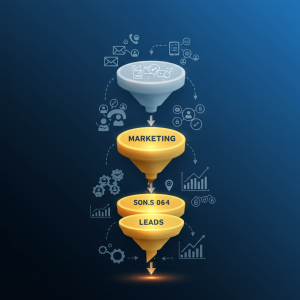Inbound vs Outbound Marketing: Which Strategy Is Right for Your Business?

In today’s competitive business landscape, having the right marketing strategy can make the difference between thriving and merely surviving. Two primary approaches dominate the marketing world: inbound and outbound marketing. While both aim to attract customers and drive sales, they differ significantly in their methodology, cost-effectiveness, and results.
This comprehensive guide will explore the key differences between these two marketing strategies, helping you determine which approach—or combination of approaches—best suits your business needs.
What is Inbound Marketing?
Inbound marketing is a customer-centric approach that focuses on creating valuable content and experiences tailored to your audience. Rather than interrupting potential customers with unsolicited messages, inbound marketing attracts prospects to your business through relevant and helpful content.
Key Elements of Inbound Marketing
- Content Marketing: Blog posts, ebooks, whitepapers, and other educational resources that address your audience’s pain points
- Search Engine Optimization (SEO): Optimizing your content to rank higher in search results
- Social Media Marketing: Engaging with your audience on platforms where they already spend time
- Email Marketing: Nurturing leads through personalized communication
- Lead Magnets: Offering valuable resources in exchange for contact information
Benefits of Inbound Marketing
- Cost-Effective: Generally requires lower initial investment than traditional outbound methods
- Long-Term Value: Content continues to attract leads long after publication
- Higher Quality Leads: Attracts prospects who are actively searching for solutions
- Trust Building: Establishes your brand as a thought leader in your industry
- Better ROI: Typically generates higher return on investment over time
What is Outbound Marketing?
Outbound marketing represents the traditional approach of pushing your message out to a broad audience. This strategy involves directly reaching out to potential customers regardless of whether they’ve expressed interest in your products or services.
Key Elements of Outbound Marketing
- Television and Radio Advertising: Broadcasting your message to mass audiences
- Cold Calling: Directly contacting potential customers via phone
- Direct Mail: Sending physical marketing materials to prospects
- Trade Shows and Events: Promoting your business at industry gatherings
- Print Advertising: Placing ads in newspapers, magazines, and other publications
- Billboards and Outdoor Advertising: Using physical spaces to display your message
Benefits of Outbound Marketing
- Immediate Impact: Can generate quick results when properly executed
- Wide Reach: Ability to reach large audiences quickly
- Brand Awareness: Effective for building broad recognition
- Targeted Demographics: Can reach specific demographic groups through strategic placement
- Competitive Visibility: Ensures presence in spaces where competitors advertise
Inbound vs. Outbound: Key Differences
| Aspect | Inbound Marketing | Outbound Marketing |
| Approach | Pull (attracts) | Push (interrupts) |
| Communication Style | Two-way conversation | One-way message delivery |
| Customer Targeting | Highly targeted | Broad audience |
| Cost Structure | Lower initial cost, long-term investment | Higher upfront costs, ongoing expenses |
| Lead Quality | Higher quality, self-qualified leads | Variable quality requires more follow-up |
| Measurability | Highly measurable and data-driven | More challenging to track precise ROI |
| Timeline | Longer-term strategy | Can produce quicker initial results |
| Customer Perception | Non-intrusive, valuable | Can be perceived as interruptive |
When to Use Inbound Marketing

Inbound marketing is particularly effective when:
- You have a longer sales cycle with considered purchases
- Your target audience actively researches solutions online
- You want to establish thought leadership in your industry
- You’re operating with a limited marketing budget but have time to invest
- Your business benefits from educational content and relationship building
When to Use Outbound Marketing
Outbound marketing can be the right choice when:
- You need immediate results and lead generation
- You’re entering a new market and need to build awareness quickly
- Your target audience isn’t actively searching for your solution
- You have a simple value proposition that can be communicated concisely
- You operate in an industry where traditional methods remain effective
Creating an Integrated Marketing Strategy
For most businesses, the most effective approach combines elements of both inbound and outbound marketing. This integrated strategy allows you to leverage the strengths of each approach while mitigating its individual weaknesses.
How to Integrate Both Approaches
- Use outbound methods to drive traffic to inbound assets: Direct mail or advertisements can point prospects to valuable online content.
- Retarget inbound visitors with outbound methods: Users who engage with your content can be retargeted with more direct advertising.
- Apply inbound principles to outbound campaigns: Make cold emails more valuable by including helpful industry insights rather than pure sales pitches.
- Gather data from inbound efforts to inform outbound targeting: Use the insights gained from content engagement to better target traditional advertising.
- Coordinate messaging across all channels: Ensure consistent brand messaging regardless of whether the touchpoint is inbound or outbound.
Measuring Success: Key Metrics to Track
Inbound Marketing Metrics
- Organic website traffic
- Content engagement rates
- Conversion rates
- Lead quality and progression
- Customer acquisition cost (CAC)
- Marketing qualified leads (MQLs)
Outbound Marketing Metrics
- Response rates
- Campaign reach and frequency
- Cost per acquisition (CPA)
- Brand awareness lift
- Sales qualified leads (SQLs)
- Return on advertising spend (ROAS)
Conclusion
Both inbound and outbound marketing strategies have their place in the modern marketing landscape. The right approach for your business depends on your specific goals, target audience, industry, timeline, and available resources.
By understanding the fundamental differences between these strategies and their respective strengths and weaknesses, you can develop a balanced marketing mix that effectively attracts, engages, and delights your customers.
Remember that marketing is not a one-size-fits-all proposition. Regular testing, measuring, and optimization are essential to finding the perfect balance between inbound and outbound tactics for your unique business needs.





